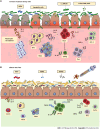Immunological mechanisms of fecal microbiota transplantation in recurrent Clostridioides difficile infection
- PMID: 36156924
- PMCID: PMC9476857
- DOI: 10.3748/wjg.v28.i33.4762
Immunological mechanisms of fecal microbiota transplantation in recurrent Clostridioides difficile infection
Abstract
Fecal microbiota transplantation (FMT) is a successful method for treating recurrent Clostridioides difficile (C. difficile) infection (rCDI) with around 90% efficacy. Due to the relative simplicity of this approach, it is being widely used and currently, thousands of patients have been treated with FMT worldwide. Nonetheless, the mechanisms underlying its effects are just beginning to be understood. Data indicate that FMT effectiveness is due to a combination of microbiological direct mechanisms against C. difficile, but also through indirect mechanisms including the production of microbiota-derived metabolites as secondary bile acids and short chain fatty acids. Moreover, the modulation of the strong inflammatory response triggered by C. difficile after FMT seems to rely on a pivotal role of regulatory T cells, which would be responsible for the reduction of several cells and soluble inflammatory mediators, ensuing normalization of the intestinal mucosal immune system. In this minireview, we analyze recent advances in these immunological aspects associated with the efficacy of FMT.
Keywords: Clostridioides difficile; Dysbiosis; Fecal microbiota transplantation; Immunity; Mechanism; Pseudomembranous colitis.
©The Author(s) 2022. Published by Baishideng Publishing Group Inc. All rights reserved.
Conflict of interest statement
Conflict-of-interest statement: All the authors report no relevant conflicts of interest for this article.
Figures


Similar articles
-
Metagenomic, metabolomic, and lipidomic shifts associated with fecal microbiota transplantation for recurrent Clostridioides difficile infection.mSphere. 2024 Oct 29;9(10):e0070624. doi: 10.1128/msphere.00706-24. Epub 2024 Oct 8. mSphere. 2024. PMID: 39377587 Free PMC article.
-
Fecal Microbiota Transplantation Increases Colonic IL-25 and Dampens Tissue Inflammation in Patients with Recurrent Clostridioides difficile.mSphere. 2021 Oct 27;6(5):e0066921. doi: 10.1128/mSphere.00669-21. Epub 2021 Oct 27. mSphere. 2021. PMID: 34704776 Free PMC article.
-
Understanding the mechanisms of efficacy of fecal microbiota transplant in treating recurrent Clostridioides difficile infection and beyond: the contribution of gut microbial-derived metabolites.Gut Microbes. 2020 Nov 9;12(1):1810531. doi: 10.1080/19490976.2020.1810531. Gut Microbes. 2020. PMID: 32893721 Free PMC article. Review.
-
The evaluation of fecal microbiota transplantation vs vancomycin in a Clostridioides difficile infection model.Appl Microbiol Biotechnol. 2022 Oct;106(19-20):6689-6700. doi: 10.1007/s00253-022-12154-z. Epub 2022 Sep 10. Appl Microbiol Biotechnol. 2022. PMID: 36085529
-
Fecal microbiota transplantation for treatment of patients with recurrent Clostridioides difficile infection.Expert Rev Anti Infect Ther. 2020 Jul;18(7):669-676. doi: 10.1080/14787210.2020.1752192. Epub 2020 Apr 12. Expert Rev Anti Infect Ther. 2020. PMID: 32266848
Cited by
-
Clostridioides difficile recurrence in individuals with and without cancer: a Swedish population-based cohort study.Infection. 2024 Apr;52(2):649-660. doi: 10.1007/s15010-024-02193-1. Epub 2024 Feb 26. Infection. 2024. PMID: 38407777 Free PMC article.
-
Intestinal Microbiome Changes and Clinical Outcomes of Patients with Ulcerative Colitis after Fecal Microbiota Transplantation.J Clin Med. 2023 Dec 15;12(24):7702. doi: 10.3390/jcm12247702. J Clin Med. 2023. PMID: 38137770 Free PMC article.
-
Gut-derived immune cells and the gut-lung axis in ARDS.Crit Care. 2024 Jul 4;28(1):220. doi: 10.1186/s13054-024-05006-x. Crit Care. 2024. PMID: 38965622 Free PMC article. Review.
-
The Importance of Microbiota and Fecal Microbiota Transplantation in Pancreatic Disorders.Diagnostics (Basel). 2024 Apr 23;14(9):861. doi: 10.3390/diagnostics14090861. Diagnostics (Basel). 2024. PMID: 38732276 Free PMC article. Review.
-
Big Data in Gastroenterology Research.Int J Mol Sci. 2023 Jan 27;24(3):2458. doi: 10.3390/ijms24032458. Int J Mol Sci. 2023. PMID: 36768780 Free PMC article. Review.
References
-
- Ruan W, Engevik MA, Spinler JK, Versalovic J. Healthy Human Gastrointestinal Microbiome: Composition and Function After a Decade of Exploration. Dig Dis Sci. 2020;65:695–705. - PubMed
-
- Bohnhoff M, Drake BL, Miller CP. Effect of streptomycin on susceptibility of intestinal tract to experimental Salmonella infection. Proc Soc Exp Biol Med. 1954;86:132–137. - PubMed
Publication types
MeSH terms
Substances
LinkOut - more resources
Full Text Sources

